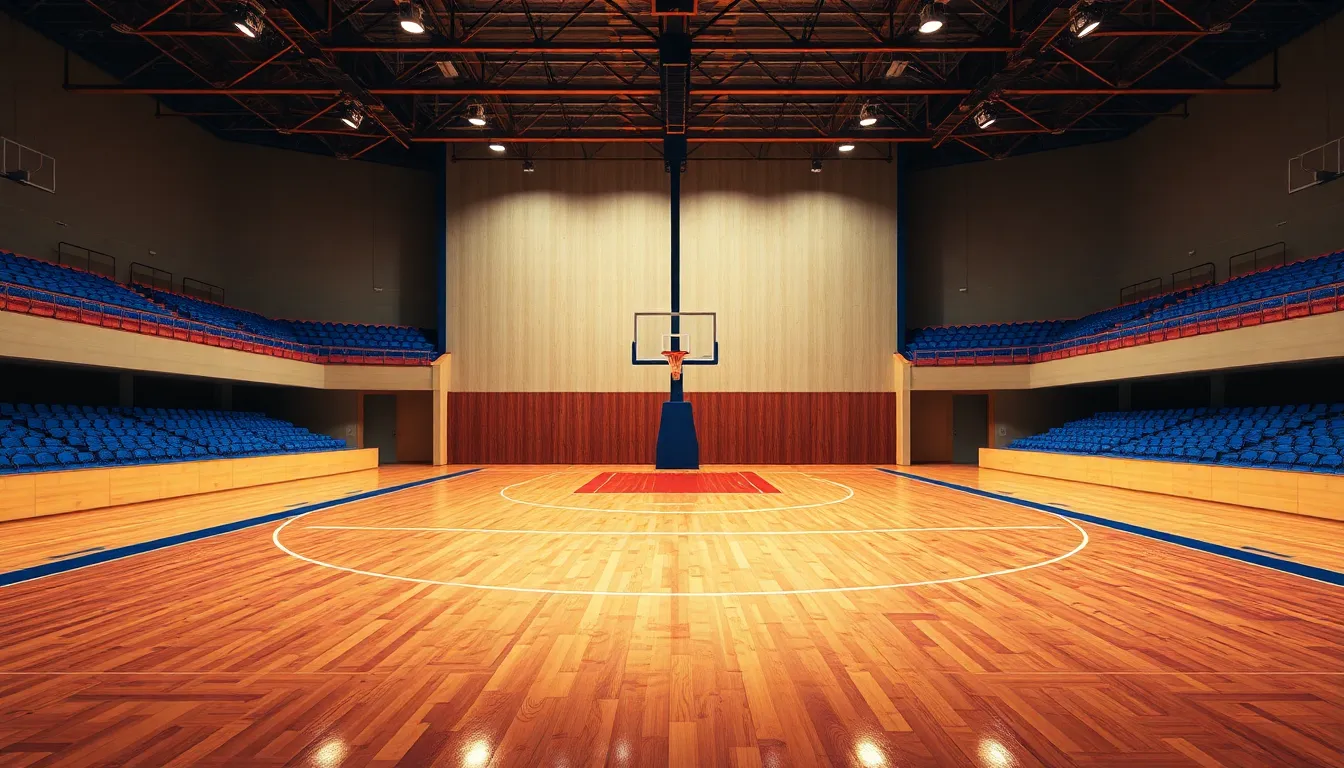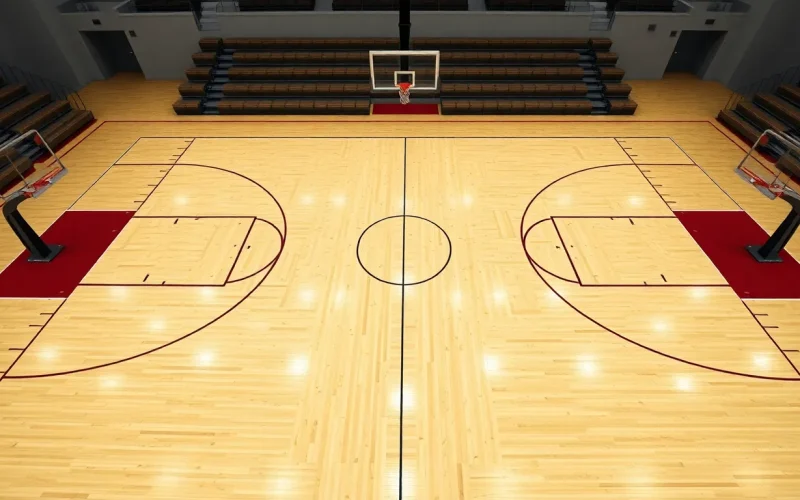Table of Contents
ToggleWhen it comes to basketball, size matters—after all, you wouldn’t want to play a game on a court that feels more like a backyard than a professional arena. So how many feet does it take to create the perfect hardwood paradise? Spoiler alert: it’s not just a hop, skip, and a jump away!
Overview of Basketball Court Dimensions
Basketball courts display specific dimensions that facilitate the gameplay experience. A standard basketball court measures 94 feet long and 50 feet wide at the professional and collegiate levels. High school courts are slightly smaller, measuring 84 feet long and 50 feet wide.
The three-point line plays a crucial role in scoring. For NBA courts, this line is 23.75 feet from the basket at the top arch, while it measures 22 feet in the corners. In college basketball, the three-point line sits at 22.15 feet from the basket.
Key features also include the free-throw line. This line is located 15 feet from the backboard. The key area, or the paint, spans 16 feet wide and extends 19 feet from the basket. The center circle measures 12 feet in diameter, facilitating tip-offs and controlled play.
Various elements contribute to court dynamics. The width of the sidelines and baselines impacts player movement, measured at 3 feet from the boundary markers. Court markings follow specific guidance to ensure consistency across various levels of play.
The distance between the basket and the floor stands at 10 feet, a universal standard recognized in all organized basketball leagues. This height directly influences shooting techniques and player skills.
Throughout the sport, these dimensions establish the playing environment, impacting both offense and defense strategies. Whether for professional or recreational play, adherence to standardized measurements enhances the overall experience and maintains competitive integrity.
Standard Dimensions of a Basketball Court

Basketball courts adhere to specific dimensions that define the playing area across various leagues. These measurements serve to standardize gameplay, ensuring consistency.
Length and Width Measurements
Professional and collegiate basketball courts measure 94 feet in length and 50 feet in width. High school courts differ slightly, stretching 84 feet long and 50 feet wide. The three-point line, crucial for scoring, is positioned at 23.75 feet from the basket in the NBA, while college courts measure 22.15 feet for the same line. Courts also feature a free-throw line, located 15 feet from the backboard. These dimensional variances have significant implications on strategies employed by players and coaches.
Height Requirements
Every basketball court maintains a universally regulated basket height of 10 feet from the floor. This height requirement applies to all levels, including NBA, collegiate, and high school competitions. The center circle measures 12 feet in diameter, providing a designated area for jump balls and tip-offs. Understanding these height parameters helps athletes optimize their shooting techniques and rebound effectiveness. With consistent height across all levels, players develop skills that translate seamlessly across different playing environments.
Variations in Basketball Court Sizes
Basketball court sizes vary depending on the level of play, impacting the overall game experience. Understanding these differences helps players and coaches adapt their strategies.
Youth and High School Courts
Youth courts typically measure 74 feet long and 42 feet wide, catering to younger players. High school courts adopt a larger space, measuring 84 feet by 50 feet. The three-point line in high school varies, often sitting shorter than its collegiate and professional counterparts. These size differences support skill development while creating a competitive environment. Most importantly, the 10-foot hoop height remains standard, allowing players to practice essential shooting techniques effectively.
College and Professional Courts
College courts measure 94 feet long and 50 feet wide, mirroring the dimensions of professional NBA courts. NBA court dimensions include a three-point line at 23.75 feet from the basket, while college courts set their line at 22.15 feet. Free-throw lines remain consistent at 15 feet away from the backboard. Both levels maintain a uniform basket height of 10 feet. Variation in court sizes impacts gameplay, affecting shooting strategies and defensive formations. Maintaining consistency across these levels enhances player performance, as they transition between formats without adjusting to significantly different dimensions.
Importance of Proper Court Dimensions
Court dimensions play a crucial role in ensuring effective gameplay. Properly sized courts create a consistent environment that promotes optimal performance at all levels.
Impact on Gameplay
Gameplay dynamics significantly depend on court measurements. For instance, a standard length of 94 feet encourages players to utilize space effectively in professional matches. Variances in court size affect shooting ranges, particularly the three-point line, which varies from 23.75 feet in NBA courts to 22.15 feet in college courts. Players develop skills during practice that directly translate to official games. Adjustments to strategies may be necessary when transitioning between youth, high school, and collegiate play as the court sizes differ. Adapting to these dimensions enhances players’ abilities to execute plays and improve overall performance.
Regulation Standards
Regulation standards maintain consistency across basketball levels. Organizations, such as the NBA and NCAA, establish specific size requirements for courts, ensuring high-quality play. Standardized dimensions, like the universally set 10-foot basket height, allow players to refine their shooting techniques. Courts measuring 50 feet wide create a balanced game, accommodating both offensive and defensive strategies. Dimensions like the key area are standardized at 16 feet wide and 19 feet deep, promoting fair competition among players. Consistency in court sizes solidifies the integrity of the sport and supports skill development throughout different levels.
Understanding the dimensions of a basketball court is essential for players and coaches alike. The variations in court sizes across different levels of play highlight the need for adaptability in strategies. Standardized measurements not only promote fair competition but also enhance skill development.
As players transition from youth to professional levels they must adjust their gameplay to fit the specific dimensions they encounter. This adaptability is crucial for optimizing performance and achieving success on the court. Ultimately the proper dimensions of a basketball court play a significant role in shaping the overall basketball experience.





